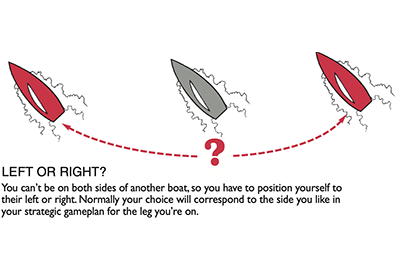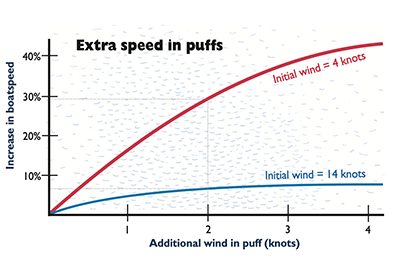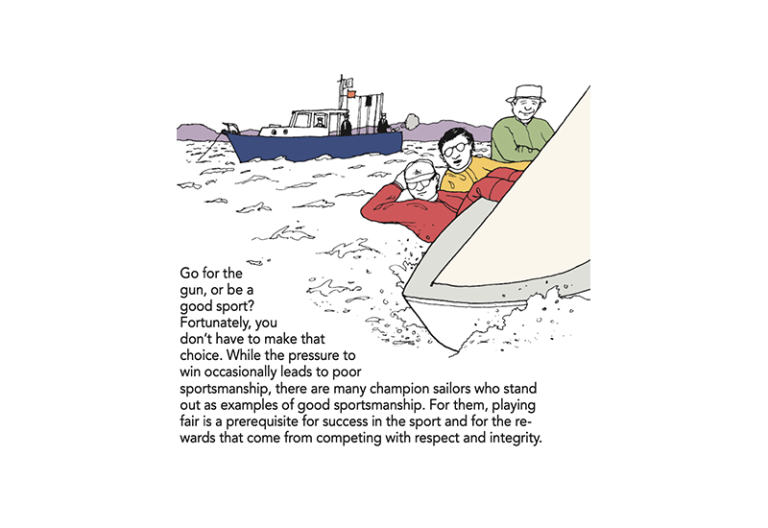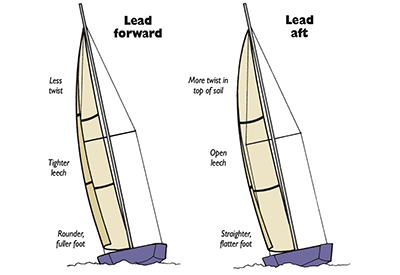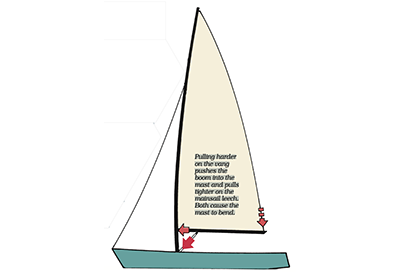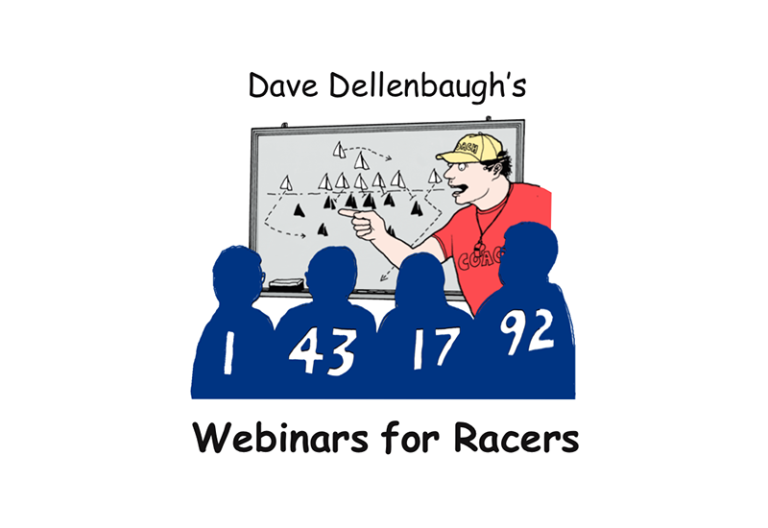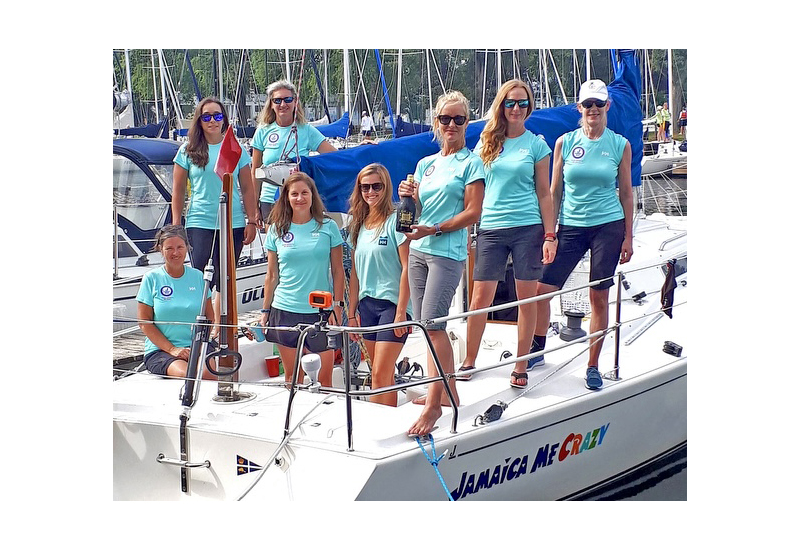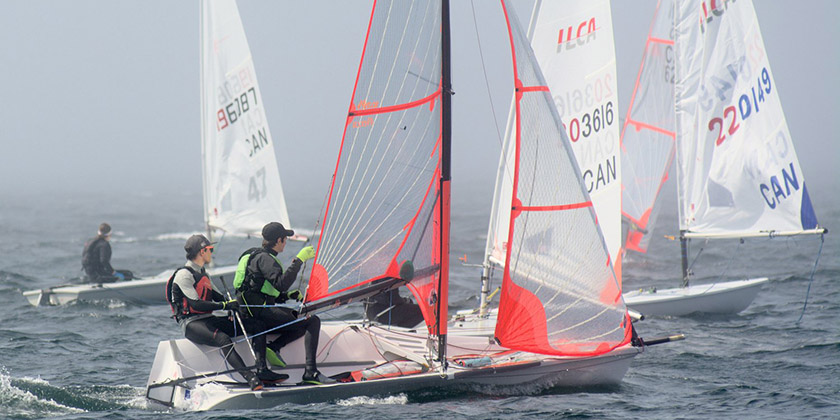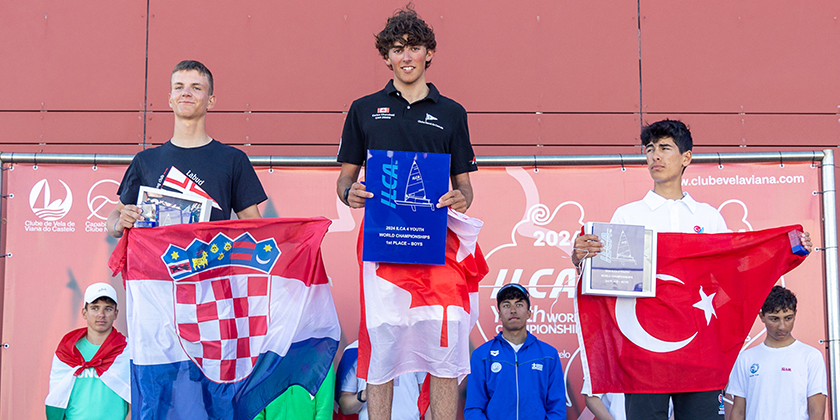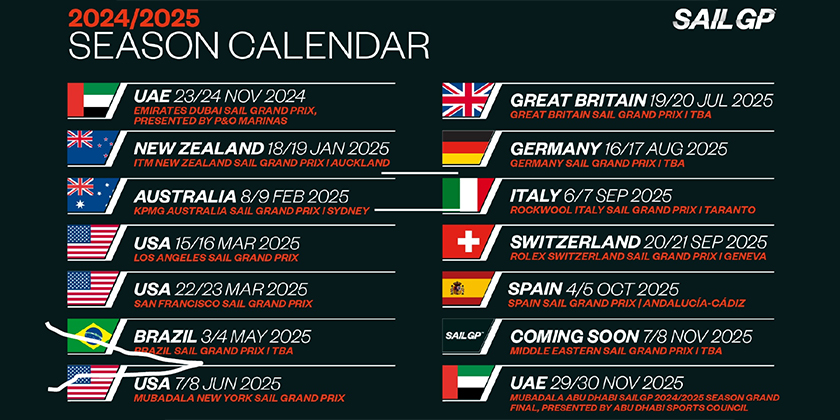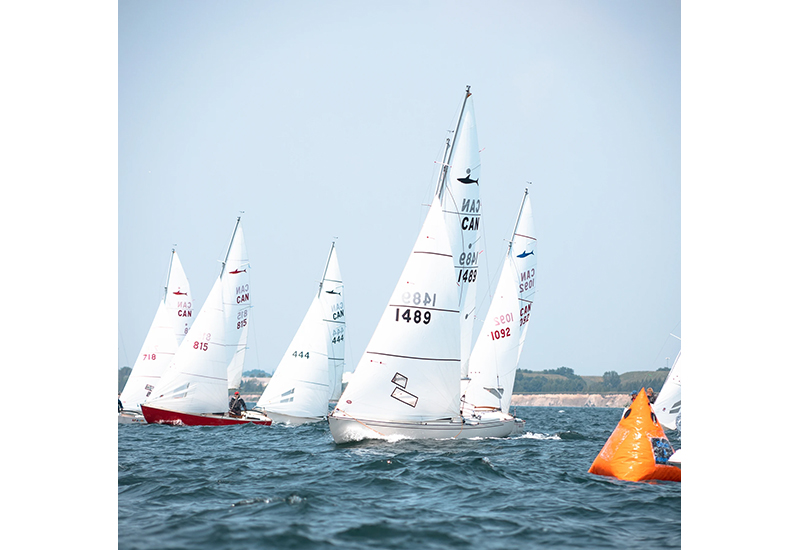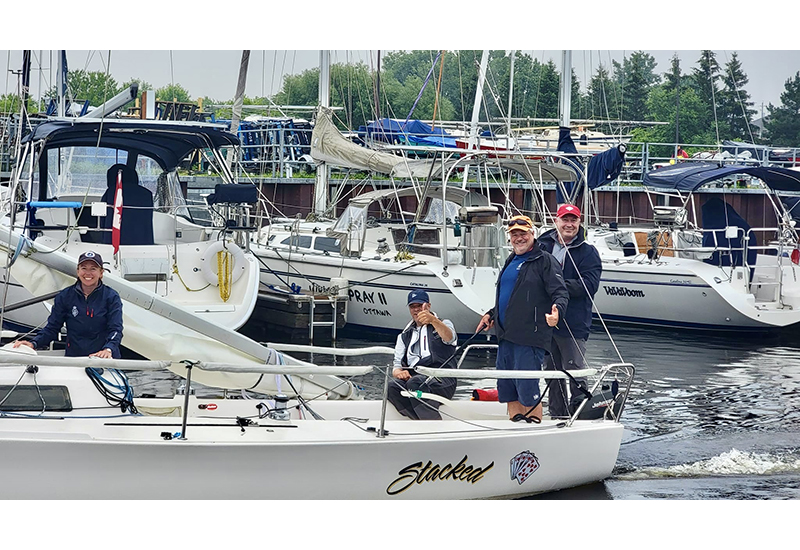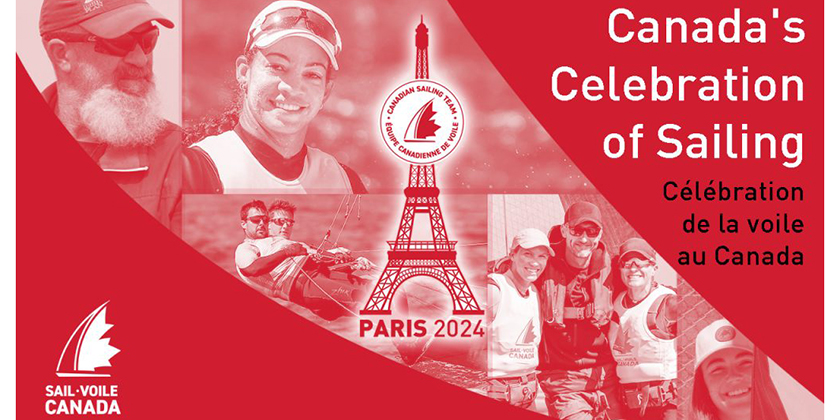Speed & Smarts: Take Control of Your Mainsail – Part 3 – Tips and Notes
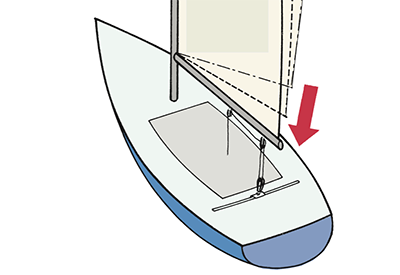
August 16, 2023
Take Control of Your Mainsail Part 1
Take Control of Your Mainsail Part 2
Tips and notes:
- Don’t cleat the sheet. The wind and wave conditions are different all the time (even when it seems like they are static), so if you want to keep going fast you have to adjust your mainsail trim continually. Try never to put the mainsheet in its cleat; if you do, you will be much less likely to make adjustments when conditions change.
- Use as few parts in the mainsheet as possible. If your class permits, try taking one part (or even two parts) out of your mainsheet in light air. Though this makes it harder to trim the main, it gives you a much better feel for pressure on the sail and lets you ease the main much more easily (which is especially important downwind).
Image below: Pulling on the sheet brings the sail in toward the middle of the boat at first, which increases the sail’s overall ‘angle of attack.’ Once the sail is trimmed near the middle, more mainsheet tension pulls the boom primarily down. This tightens the leech between head and clew, reducing twist and increasing the angle of attack at the top of the main.
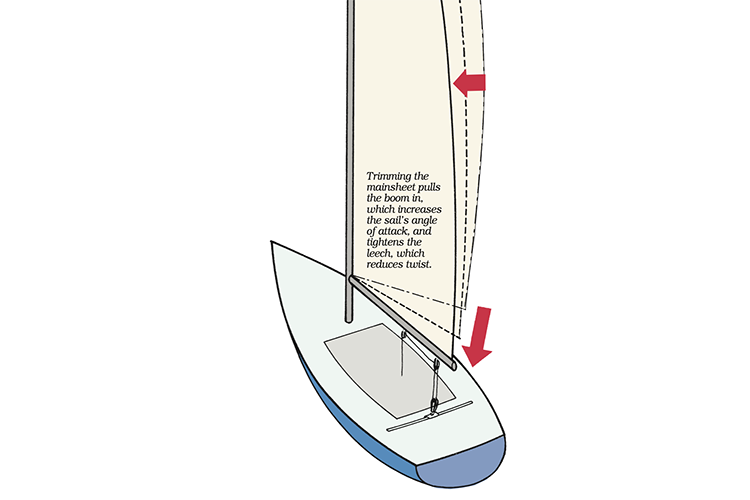
- Ease for speed, trim for height. When trimming the mainsail, it’s important to observe your performance relative to nearby boats. If you are going slower than they are, try easing the sheet a little. If your speed is good but pointing is a problem, try trimming slightly harder.
- Use vang and traveler. In breeze, it may be difficult to get the right mainsail shape with just mainsheet (and it’s hard to play the sheet). That’s why you should adjust the vang and traveler in concert with the sheet. The vang helps pull the boom down, while the traveler makes it easier to change the sail’s angle of attack.
- Is backwinding OK? When it’s breezy, some backwinding of the main along the luff (mast) is normal and won’t hurt your speed. But if this gets to be more than just a subtle bubble, you may have to trim the sheet a little harder to flatten the sail and open the slot.
- Downwind trim. In general, you should ease the mainsheet until you see slight backwind along the front of the sail, then trim it in a little.
Other tips and notes:
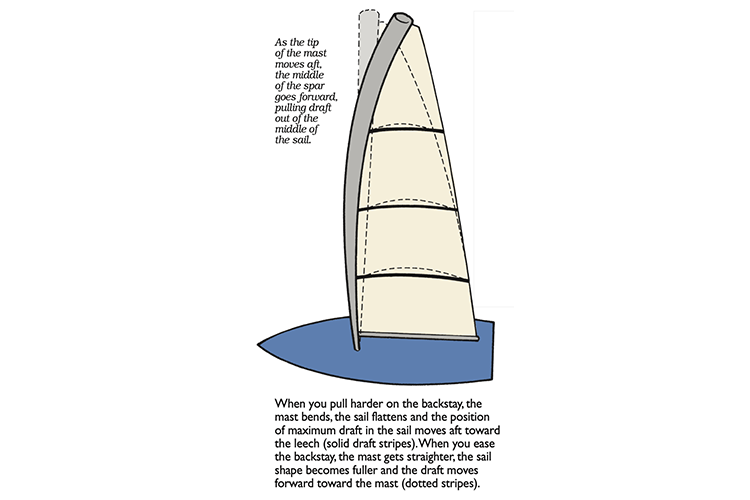
- Watch for overbend wrinkles. The backstay bends the mast and helps make the mainsail flatter when you are getting overpowered. However, it is very easy to pull the backstay too hard. One clear sign that you are near maximum backstay tension is the appearance of overbend wrinkles running from the clew toward the middle of the mast. If you have more than a hint of these wrinkles, ease the backstay slightly (or tension the checkstays if you have them) to straighten the mast and put a little more shape into the sail.
- Ease backstay downwind. When you’re sailing on a run, it’s not fast to pull the top of the mast aft. Ease the backstay until the mast is vertical in the boat or actually raked forward (but in windy conditions don’t ease the backstay so much that the mast has reverse bend). On an overpowered reach, it’s OK to keep the backstay on to depower the sailplan.
- Adjust backstay, adjust mainsheet. When you tension the back- stay, it pulls the top of the mast aft. If you don’t touch the mainsheet, the leech of the sail will twist off to leeward because the top of the mast is closer to the aft end of the boom. Therefore, whenever you adjust the backstay, you should make a corresponding change in mainsheet. If you tighten the backstay, tighten the sheet. If you ease the backstay, ease the sheet or the leech will get too tight (because the tip of the mast moves farther away from the end of the boom).
- Use the backstay to change gears. When conditions change, don’t forget the backstay. As you get a puff, pull on more backstay to flatten the main and reduce headstay sag (which flattens the jib). In a lull, ease the backstay to add power to the overall sailplan.
- Don’t get hung up. On some boats, the backstay often gets caught on the mainsail leech or the top batten during tacks or jibes. You may be able to prevent this by using some sail repair tape (with lube spray) to smooth over the spot that catches. It also may help
to keep the backstay slightly taut (rather than loose), or to ease the main out quickly (and then re-trim it) just after completing a tack.
More tips and notes:
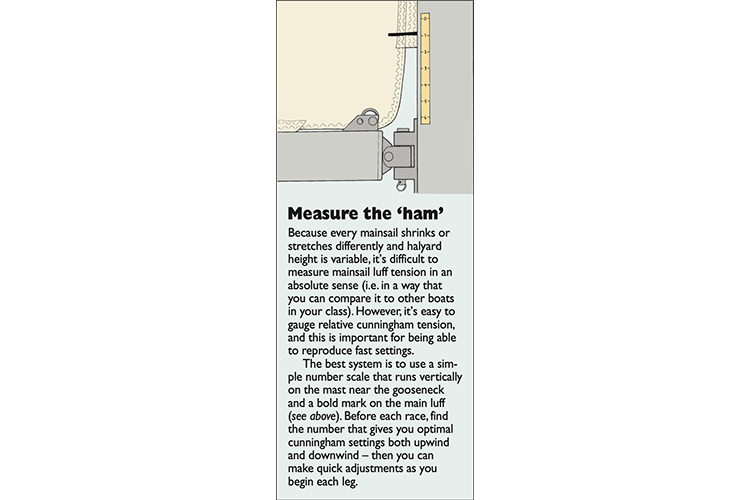
- Older sails need more luff tension. Most mainsails stretch (or shrink) as they get older and lose their fast designed shape. The sails typically become deeper, and the position of maximum draft moves aft (toward the leech). To compensate for this, you typically need to pull a little harder on the cunningham than you would for a newer sail. This additional luff tension takes some fullness out of the sail and helps move the draft forward toward its original position. With older sails you will seldom end up with the ‘speed wrinkles’ that you see in newer sails.
- Don’t forget the halyard. There are two ways to adjust mainsail luff tension – cunningham and halyard. Sometimes the main halyard is locked in one position, but on other boats it’s adjustable and has a large effect on mainsail shape. In light air, if you pull the halyard all the way up you may have too much luff tension, even if the cunningham is completely eased. I usually set the main halyard so the luff tension is perfect downwind; then I use cunningham if necessary to get more luff tension upwind.
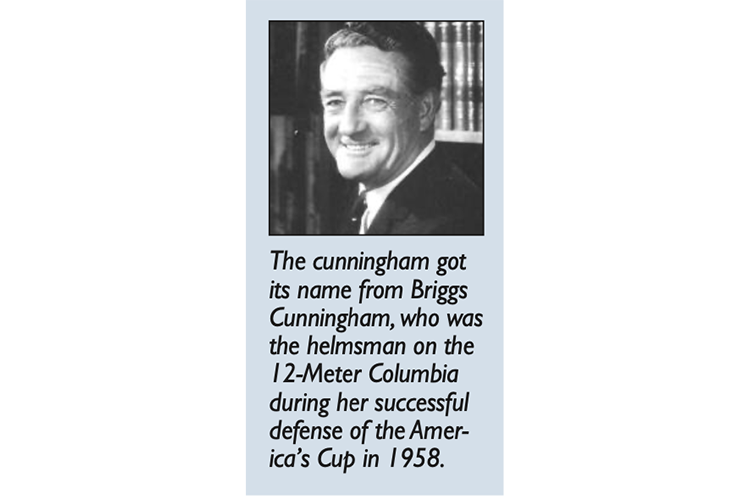
- Cunningham downwind. When you’re sailing downwind, you generally need less luff tension than sailing upwind. That’s because the mast gets a lot straighter on runs, and it’s all right if the draft is a little farther aft than 45%.
In addition, the sail should usually be fuller downwind, so you don’t want the flattening effects that you get with more luff tension. One exception is when you’re on an overpowered reach; in that case, it’s good to maintain lots of cunningham to depower the mainsail.
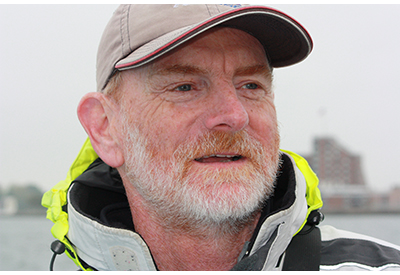 Dave Dellenbaugh is the publisher, editor and author of Speed & Smarts, the racing newsletter. He was the tactician and starting helmsman on America3 during her successful defense of the America’s Cup in 1992 and sailed in three other America’s Cup campaigns from 1986 to 2007. David is also two-time winner of the Canada’s Cup, a Lightning world champion, two-time Congressional Cup winner, seven-time Thistle national champion, three-time Prince of Wales U.S. match racing champion and past winner of the U.S. Team Racing Championship for the Hinman Trophy. He is currently a member of the US Sailing Racing Rules Committee (and was its chairman from 2005-2008).
Dave Dellenbaugh is the publisher, editor and author of Speed & Smarts, the racing newsletter. He was the tactician and starting helmsman on America3 during her successful defense of the America’s Cup in 1992 and sailed in three other America’s Cup campaigns from 1986 to 2007. David is also two-time winner of the Canada’s Cup, a Lightning world champion, two-time Congressional Cup winner, seven-time Thistle national champion, three-time Prince of Wales U.S. match racing champion and past winner of the U.S. Team Racing Championship for the Hinman Trophy. He is currently a member of the US Sailing Racing Rules Committee (and was its chairman from 2005-2008).
You can subscribe to the Speed & Smarts newsletter HERE.

